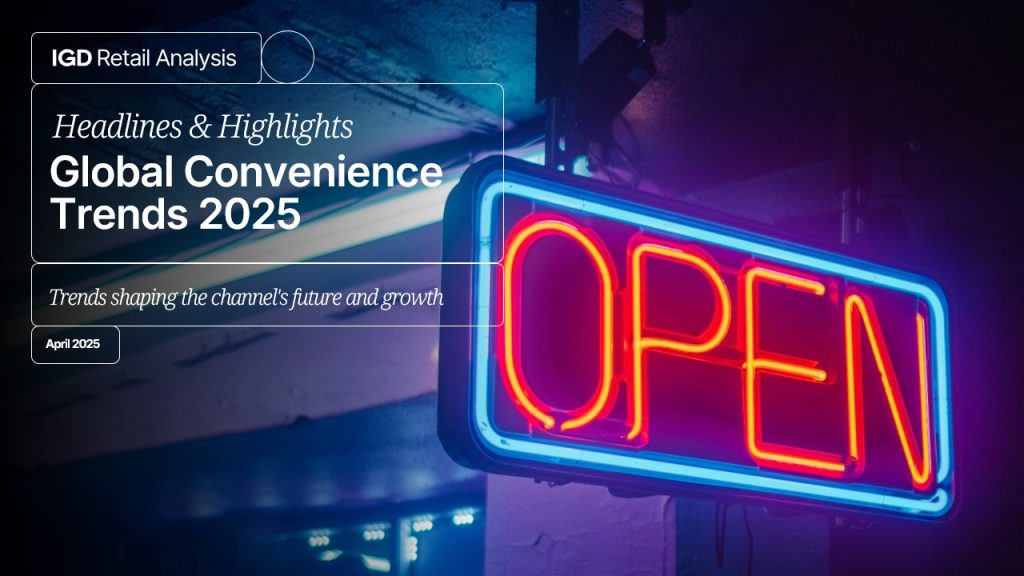How Five Key Trends are Driving Growth: From Tech-Driven Innovation to Sustainability, Discover How the Industry is Evolving to Meet Modern Consumer Demands with a Projected CAGR of 4.1% to meet the needs of modern shoppers.
The IGD Global Convenience Trends Report 2025 reveals significant changes ahead for the convenience retail sector. Sales are projected to exceed $1 trillion by 2029, driven by a compound annual growth rate (CAGR) of 4.1%. This growth is fuelled by five key trends: Tech Evolution, Food Mission, Shifting Space, Targeted Value and Striving for Better
Retailers need to adopt new convenience models, enhance store formats, and integrate digital tools, while suppliers need to adapt product strategies to emerging food trends and convenience needs. The report outlines five key global trends shaping the future of convenience retail:
1. Tech Evolution: New stores are leveraging technology to adapt to and meet changing shopper behaviours.
2. Food Mission: Convenience now includes dine-in options, on-the-go snacking, food for later, and drinks.
3. Shifting Space: Efficient space reallocation boosts revenue and enhances the customer experience.
4. Targeted Value: Promotions and loyalty programs are evolving to be personalised and targeted.
5. Striving for Better: Sustainability and health initiatives are becoming crucial for meeting consumer demands.
The convenience channel remains the third-largest modern trade channel over the next five years but faces strong competition, impacting its growth. While the global grocery market is projected to grow annually by 4.2%, the convenience channel’s growth is slightly behind, at 4.1%. This will mean the convenience channel will lose market share, from 10.7% in 2024 to 10.6% in 2029. This share loss is largely due to the faster growth of smaller, but rapidly expanding, channels: discount and online. Discount retailers will attract budget-conscious shoppers, while online retailers will offer a breadth of range that convenience stores struggle to match. Supermarkets, despite their slower growth, are also becoming a greater threat to convenience stores. Operators are expanding their smaller footprint formats.
To stay competitive, retailers must differentiate through enhanced in-store experiences, strategic space allocation, and value-driven promotions. Sustainability and health initiatives are also crucial for meeting consumer demands and enhancing brand image.
Sneha Haria, Insights Manager, emphasises, “Convenience retail is evolving from quick transactions to smart, seamless experiences. Our report highlights key trends like digital innovation and healthier food options that will define success in 2025 and beyond. While the sector uses its proximity and adaptability to meet consumer trends, it must address costs and competition challenges. Retailers need to close the price perception gap with other channels and make targeted value visible across regions. Sustainability and health are emerging trends globally, even though they are not typically front of mind for convenience shoppers.”
What Does This Mean for the Future?
The IGD Global Convenience Trends Report provides actionable insights for retailers and suppliers to inform business plans over the next five years. Retailers must adopt new convenience models, enhance store formats, and integrate digital tools, while suppliers should adapt product strategies to emerging food trends and convenience needs.
The report highlights what retailers can do to gainstand out:
1. Tech Evolution: Convenience retailers must use technology to streamline operations, enhance the customer experience, and drive growth. Areas to look at include retail media, loyalty apps, and creating a seamless omnichannel experience.
2. Food Mission: Convenience retailers can differentiate themselves by showcasing a range across both food-to-go and food for later propositions. They should explore different dayparts and global cuisines.
3. Shifting Space: Convenience stores must strategically allocate space to differentiate with non-grocery categories and value-added services. Promptly adapt to new legislation by adding facilities that help shoppers adjust to changes.
4. Targeted Value: Transaction sizes are small, making value a critical lever to drive frequency. Value is not just about price; it’s about adding interest to daily luxuries and building stronger engagement with shoppers.
5. Striving for Better: Adopt sustainability and health initiatives to enhance brand image, improve operational efficiency, and meet consumer demand for eco-friendly and healthier products. These efforts can lead to long-term cost savings and customer loyalty.
Retailers can stay competitive, but they must enhance the in-store experience and showcase food-to-go and food-for-later propositions. By exploring new ways to stand out with food counters and differentiated ranges and cuisines, as well as bundling products as part of meal deals, these enhancements will help increase spend per trip and provide greater value to shoppers.
To download the Global Convenience Trends Report, visit IGD’s website.


